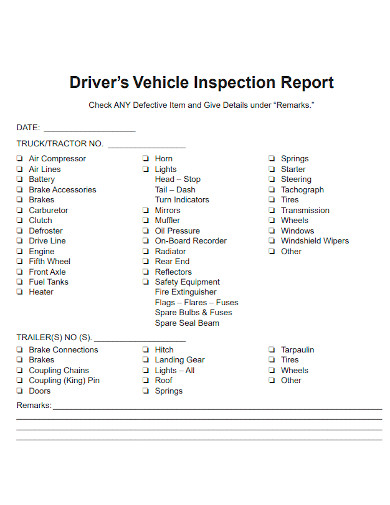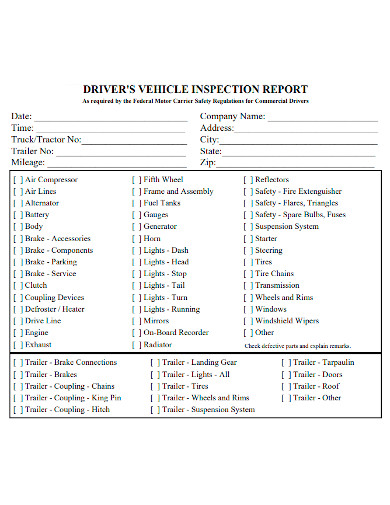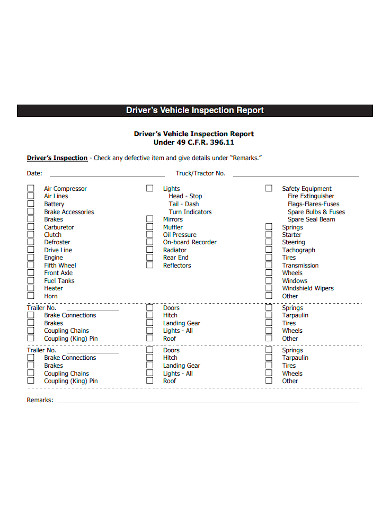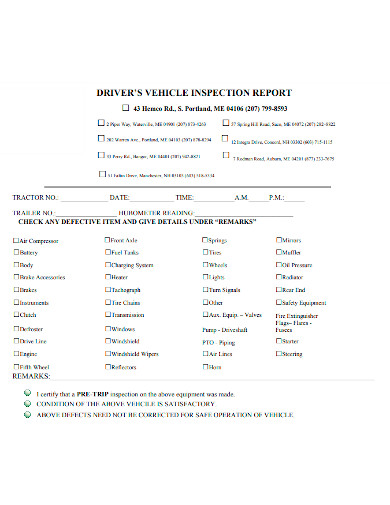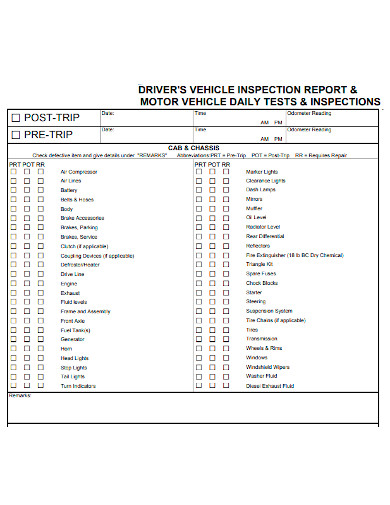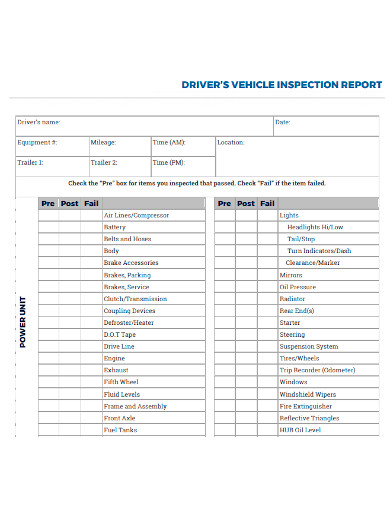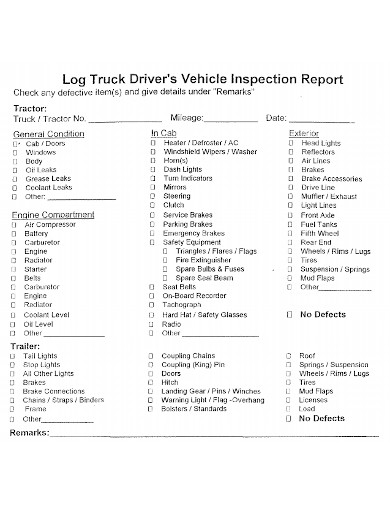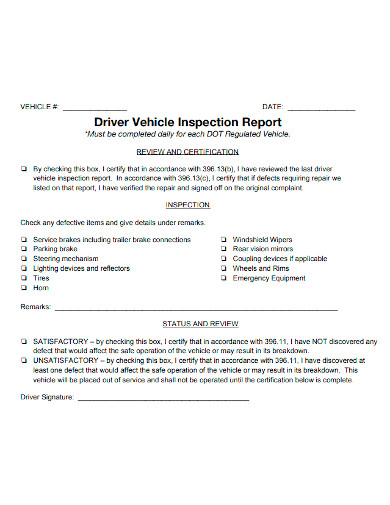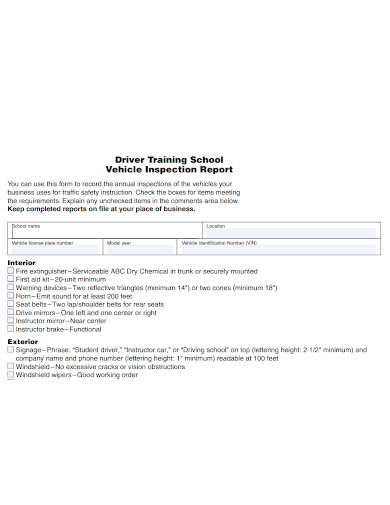Whether it’s required by law regulations or a company policy, letting drivers fill out a driver’s vehicle inspection report daily is an important part of the systematic compliance of a vehicle maintenance program. All vehicles must be roadworthy enough to avoid accidents and crashes that cause devastating effects to the vehicle and driver. Conducting an inspection also prevents companies from shelling out hundreds or even thousands of dollars of repairing major defects of a vehicle just because they are not maintained properly. Even with insurance, paying for car damages can still put some dent in the budget. The essence of a vehicle inspection is having a qualified mechanic and the driver review the car and complete the inspection process to check if the vehicle needs repairs before making the report and give a go signal that the vehicle can be operated. This article will guide you on how to make a driver’s vehicle inspection report.
10+ Driver’s Vehicle Inspection Report Samples
1. Driver’s Vehicle Inspection Report Sample
2. Printable Driver’s Vehicle Inspection Report
3. Standard Driver’s Vehicle Inspection Report
4. Driver’s Vehicle Inspection Report Format
5. Formal Driver’s Vehicle Inspection Report
6. Driver’s Daily Vehicle Inspection Report
7. Driver’s Motor Vehicle Inspection Report
8. Editable Driver’s Vehicle Inspection Report
9. Truck Driver’s Vehicle Inspection Report
10. General Driver’s Vehicle Inspection Report
11. Driver’s Training School Vehicle Inspection Report
What is a Driver’s Vehicle Inspection Report?
A driver’s vehicle inspection report (DVIR) is a written document or form done by a qualified mechanic or the driver themselves to comprehensively check the whole vehicle visually and inspect how safe the vehicle is driven on the road. If they will identify any parts or areas in the vehicle that may be unsafe or due for replacement, they a written report to mention all the problems they’ve discovered. The report will be then sent to the company that owns the vehicle for them to fix the defects before anyone will drive the vehicle. DVIRs are traditionally and generally created using paper but they can also be created through electronic devices. A DVIR is required by law under the Federal Motor Carrier Safety Regulations, as enforced by the U.S. DOT’s Federal Motor Carrier Safety Administration (FMCSA).
How to Make a Driver’s Vehicle Inspection Report
The law regulations specify what has to appear on a DVIR. It should include the following details:
- The date when the inspection is done
- The vehicle identity (fleet unit number, license plate number, etc.)
- The list of car parts that need to be inspected and a box beside it that signifies if it has been inspected
- A remarks column beside the list or a remarks row below the list where the person inspecting will write if the vehicle needs repairs or not
- Acknowledgment if the vehicle is safe to use or it needs repair
- The signature of the driver or mechanic who prepared the DVIR
- The signature of the mechanic who inspected and repaired the vehicle
- The signature of the driver who inspected the vehicle acknowledging that the repair was done or not needed
FAQs
Who has to fill out DVIRs?
The people who are required to fill out DVIRs are:
- Drivers who drive commercial trucks or buses weighing 10,001 pounds or more or designed for nine or more passengers
- Companies that operate the vehicles mentioned above
Drivers who carry passengers have to prepare DVIRs once they’re driving for the day to report any defects in the vehicle. Truck drivers only prepare a DVIR if there is a safety-related defect that needs to be reported unless their company requires them to make a report every day.
Which vehicle parts have to be included in the inspection?
The DVIR inspects these parts to examine if there are any defects in them:
- Foot brakes
- Hand brakes
- Steering system
- Lights and reflectors
- Tires, wheels, and rims
- Horns
- Windshield wipers
- Rearview mirrors
- Emergency equipment such as fire extinguishers, reflective triangles, or spare fuses
What if a driver or a company violates the DVIR rules?
If any driver or a company violates it, they have to pay hefty penalties. Failing to complete a DVIR when required, falsifying a DVIR, or failing to repair a reported safety defect results in violating the DVIR.
The frequency of doing the inspection may depend on how oftentimes the vehicle is being operated. For example, if the vehicle is owned by an office company and the vehicle is not often used in heavy workloads, it only needs less inspection compared to vehicles being used in intense labor and use of machinery and heavy equipment. Furthermore, the frequency can also be affected based on your risk assessment. Make sure to regularly review your risk assessment documents to ensure you’re on the right track of inspecting your vehicles. To help you get started making your inspection report, download our free sample templates above to use as your guide!
Related Posts
Sample Chemistry Lab Reports
Field Report Samples & Templates
Sample Science Project Reports
Business Report Samples & Templates
Survey Reports Samples & Templates
Sample Feasibility Reports
Psychological Assessment Report Samples [ Clinical, Child, Intake ]
Report Format Samples & Templates
Acknowledgement for Internship Report Samples [ Hotel, Hospital, Teaching ]
Field Trip Report Samples [ Agriculture, Educational, Environmental ]
Student Counseling Report Samples
Narrative Accomplishment Report Samples [ Science, Teacher, Reading ]
Sample Acknowledgment Report Templates
Internship Narrative Report Samples
Interview Summary Report Samples

